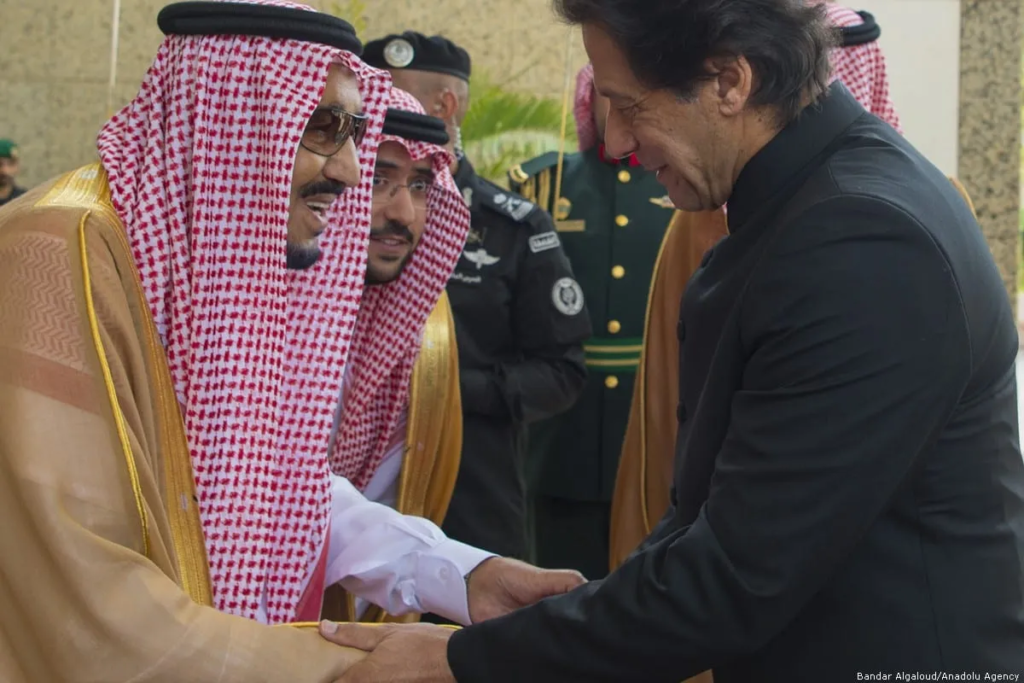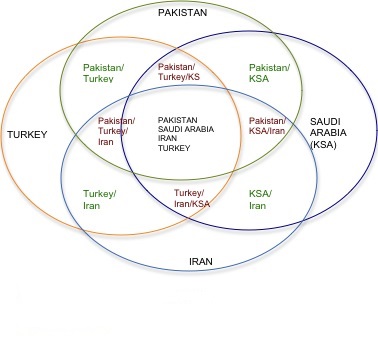Context
As the global balance power remains in flux, some dramatic changes indicate how complicated this shift has become. The equilibrium is swinging between the established and the emerging powers with both striving to shape the process of change towards their camp. As the tug and pull continues between US, Russia, and China, the Cold War era alliances can no longer be trusted. The present political and economic ecosystems present different realities that require a fresh formulation of allies.
Analysis
As these partnerships relate to the Middle East and South and Central Asia regions, the middle powers such as Saudi Arabia, Turkey, Iran, and Pakistan, have emerged as the key players striving to maintain a semblance of stability. While a lot has been written about the policies of these nations, Saudi Arabia is the recent entrant to the fray. The Kingdom is not just an oil powerhouse; it is the anchor of the Islamic world, hosting the most revered of its holy sites. What happens in Saudi Arabia is a matter of grave concern for all.
Like other international players, Saudis also desire to hedge their bets i.e., if something were to go wrong with its existing partnerships. For example, the news of the disappearance of the prominent Saudi journalist Jamal Khashoggi after visiting the Saudi consulate in Turkey has rattled the otherwise stable US-Saudi relations. Allegedly, Khashoggi was murdered at the consulate due to his strong criticism of the royal family, through his columns in The Washington Post.
The hedging strategy was also evident when after the conclusion of the recent visit of Pakistan’s new premier to Saudi Arabia, came the news about its intent to join one of the tributaries of the Belt and Road Initiative (BRI) the China-Pakistan Economic Corridor (CPEC). According to media reports, Saudis plan to set up an oil city in Gwadar. Apparently Pakistan has invited the Saudis to join CPEC, but it could very well be that the Saudis had asked for an invitation, to solidify the other flank against Iran.
At the same time, Saudi Arabia also appears to be spearheading the formation of US led Arab NATO. There were rumors that US is likely to announce the formation of Arab NATO by January 2019. The members of the alliance include Saudi Arabia, United Arab Emirates, Oman, Bahrain, Kuwait, Jordan, and Egypt.
Significant challenges remain to make this alliance fully operational, mainly due to differences on the aims and objectives of the coalition, and discord amongst GCC nations over the role of Qatar and its backing of Iran. Nonetheless, up until the disappearance of Saudi journalist Jamal Khashoggi, the Saudis have had the closest relations with the US as compared to the other middle powers like Turkey, Pakistan, and Iran, and this puts the Kingdom in a unique position.
With its military intrusion in Yemen, accompanied by economic and political blockade of Qatar, the role of Saudi Arabia has become increasingly contentious. Its policies are in gradual transformation from talking about the Ummah to ‘Saudi First’, and possible change in its traditional stances towards Palestine, Kashmir, and Afghanistan. The strongest statements of solidarity on Kashmir have recently come from Iran and Turkey.
It is these shifts that are likely to become more pronounced in the coming days. With Saudi Arabia getting more aligned with the US, and the attempts to form an Arab NATO, will increase the challenges for Pakistan and Turkey. This is especially true if the main objective of the Arab NATO is to counter Iran. Both Pakistan and Turkey want to prevent a direct confrontation between Saudi Arabia and Iran.

While Pakistan is already a member of the Saudi led Alliance IMCTC (Islamic Military Counter terrorism Coalition), the nation has maintained that its primary mission is to protect the sovereignty of the Kingdom. This task can become quite complicated if Saudi royal family begins to loose their legitimacy as the custodians of the holy sites.
In this context, the involvement of Saudi Arabia in CPEC, will likely complicate Pakistan’s predicament. The Kingdom will likely use it as a pressure point on Pakistan to steer clear of Iran and stay hooked to them. On the other hand, Pakistan will exploit the Saudi engagement as leverage against India and Afghanistan, and potentially to influence the US. As the Saudi policy shift matures, the tilt seems more towards India and the US, and this will complicate Pakistan’s quandary even more.
While Pakistan has provided security guarantees to the Kingdom, if the push comes to shove, it can hardly sustain an unpopular monarchy. Protecting the holy sites and the royal family are not synonymous. The question at that point would become, who will protect the revered sites?

Conclusion
In this complex landscape, an interplay of three sets of relations are important to understand. One of them is composed of Pakistan, India and the US; the second one constitutes Russia, China and the US; and the third one is made up of Pakistan, Saudi Arabia, Iran, and Turkey.
Due to the shifting balance of power, a competition is brewing in all three segments referenced above. As the shift in the global balance of power progresses, there will be a number of reverses that may reflect that the more things change, the more they stay the same. However, these will be merely momentary allusions as the status quo is now impossible to maintain.
The present tensions between the US and the Saudis over the disappearance of Jamal Khoshoggi will prove to be short lived – as there is otherwise complete unanimity of interests between the two. US simply cannot afford to alienate all four middle powers: Turkey, Pakistan, Iran and Saudi Arabia at the same time. As US contemplates and attempts to correct this dependence and imbalance, Pakistan and Turkey could emerge as the momentary beneficiaries.





